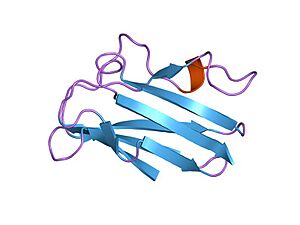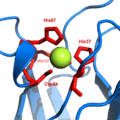Hans Freeman facts for kids
Quick facts for kids
Hans Freeman
|
|
|---|---|
| Born |
Hans Charles Freeman
26 May 1929 |
| Died | 9 November 2008 (aged 79) Sydney, Australia
|
| Alma mater | University of Sydney |
| Known for | Protein crystallography |
| Spouse(s) | Edith Freeman (née Siou), married 1966 |
| Children | 2 |
| Awards |
|
| Scientific career | |
| Fields | Inorganic chemistry, Biochemistry |
| Institutions | University of Sydney (1954–2008)
|
Hans Charles Freeman (26 May 1929 – 9 November 2008) was an important Australian chemist. He was born in Germany and later moved to Australia. He spent most of his career teaching and doing research at the University of Sydney.
Hans Freeman was best known for his work on special proteins called copper proteins. He helped explain how these proteins work. He also brought a new way of studying proteins, called protein crystallography, to Australia. He strongly believed that Australian scientists should have access to large, advanced science tools. He received many awards for his contributions to science.
Contents
Biography
Early Life and Education
Hans Charles Freeman was born in 1929 in Breslau, Germany. This city is now called Wrocław and is in Poland. In 1938, his family, who were Jewish, moved to Australia to escape the Nazi party.
Hans's father started a company that made detergents and soap. Hans often worked in the factory on weekends. This gave him a good understanding of chemistry in real life.
Hans quickly learned English and did very well in school. He was the top student (dux) at his primary school and at Sydney Boys High in 1945. He earned a special medal for his chemistry degree from the University of Sydney in 1949. Many of his high school classmates also became chemistry professors.
After getting his Master's degree in 1952, Hans went to Caltech in the United States. There, he learned about crystallography, which is a way to study the structure of materials. He earned his PhD in 1957.
Family Life
Hans Freeman came to Australia with his parents and his sister, Eva. After his father passed away in 1958, Hans became a director of the family's detergent company.
In 1964, he met Edith Siou, and they got married in 1966. They had two children, Maeva and Philip.
Career in Chemistry
Hans Freeman started working at the University of Sydney in 1954 as a lecturer. He became the first Professor of Inorganic Chemistry there in 1971.
He was one of the first people in Australia to use computers for crystallography. He used SILLIAC, which was Australia's second computer, installed in 1956. His research group studied the structures of many different chemical compounds.
In 1970, Hans Freeman started focusing on protein crystallography. He studied blue copper proteins, especially one called plastocyanin. These proteins have a bright blue color and unusual properties.
In 1977, his team finally figured out the structure of plastocyanin from the poplar tree. This was the first time a protein crystal structure was found in the southern hemisphere. This work helped scientists understand how these blue copper proteins work.
Later, Hans Freeman became interested in using a method called EXAFS spectroscopy to study proteins. In 1988, his group was the first to find a new protein structure using a method called MAD.
Helping Australian Science
Hans Freeman was always worried that Australian scientists might be held back because they were far from big research facilities. In 1972, he helped create the Foundation for Inorganic Chemistry at the University of Sydney. This foundation brought famous scientists from around the world to Australia to teach and give talks. This helped Australian students and researchers connect with leading chemists from other countries.
Freeman also advised the Australian Government on how to help scientists get access to ""big science"" facilities. These are very large and expensive tools like synchrotron X-ray machines. His work helped create a program that funded Australian researchers to use these facilities. This program eventually led to the Australian Synchrotron being built much sooner than planned.
Hans Freeman officially retired in 1997. However, he continued to do research and teach first-year students. People described his teaching as "charismatic," and he truly loved teaching science.
Legacy
Hans Freeman played a huge role in starting the study of structural biology in Australia. He set up the first laboratory in Australia dedicated to protein crystallography. By the time he passed away, there were at least 15 such research groups in Australia and New Zealand.
Many of his former students and researchers went on to lead their own groups. Freeman also helped form the Society of Crystallographers of Australia and New Zealand in 1976. He was its first president.
His main scientific achievements include understanding plastocyanin and other blue copper proteins. He also helped develop the MAD method for studying protein structures. His efforts to ensure Australian scientists could access "big science" facilities will continue to help researchers for many years. He also inspired many students to love science through his teaching.
Honours and Awards
Hans Freeman received many awards and honours for his work.
He became a Fellow of the Royal Australian Chemical Institute in 1968. He also became a Fellow of the Royal Society of Chemistry in 1984 and the Australian Academy of Science in 1984.
The Australian Government recognized him with a Centenary Medal in 2001 for his "service to Australian society and science in chemistry." In 2005, he was made a Member of the Order of Australia for his work in bio-inorganic chemistry and for developing crystallography in Australia.
Other awards he received include:
- The Burrows Award in 1980.
- The Leighton Memorial Medal in 1999, which is a very important award for chemistry in Australia.
- The Craig Medal in 2007.
- A Distinguished Fellowship from the Royal Australian Chemical Institute in 2007.
Images for kids



